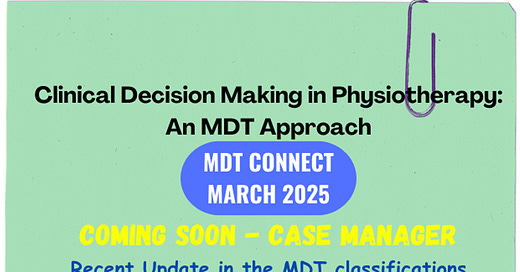Clinical Decision Making in Physiotherapy: An MDT Approach
MDT Connect | Volume 1, Issue 4 | March 2025
Clinical Decision Making in physiotherapy: An Mechanical Diagnosis and Therapy (MDT) approach
Dr Sagar Mahajan (PT), MPTh (Musculoskeletal Condition), Cert MDT, Consultant Physiotherapist, Nine Pearls Hospital & MUHS
Clinical decision-making (CDM) in physiotherapy is a continuous and evolving process where clinicians gather, analyze, and assess patient data to determine the most effective evidence-based intervention. Over time, this process develops through experience and practice, requiring a high level of skill and expertise. These skills are crucial for making informed decisions that ensure the best possible outcomes in patient care.
In physiotherapy, the McKenzie Method of Mechanical Diagnosis and Therapy (MDT), developed by Robin McKenzie, integrates clinical decision-making (CDM) to effectively treat musculoskeletal conditions of the spine and extremities. This approach categorizes conditions based on patients' responses to specific movements and postures, enabling clinicians to select the most appropriate management strategies. By focusing on how patients' symptoms react to movement patterns, the McKenzie Method guides decision-making, helping clinicians tailor interventions to optimize treatment outcomes.
Additionally, research indicates that as clinicians progress through higher levels of education and training in the McKenzie Method of MDT, they develop advanced skills and expertise. This progression is reflected by a greater consistency among MDT clinicians in accurately classifying various spinal and extremity conditions. As a result, management strategies for these patients remain uniform, minimizing variability in outcomes.
The core principles of the MDT system that influence clinical decision-making are:
Advantages of MDT:
Standardized Assessment: Provides a clear, repeatable framework for classifying musculoskeletal conditions.
Patient self-management: Encourages active patient participation while reducing reliance on passive treatments.
Prevention of Recurrence: Focuses on educating patients about self-care strategies, promoting long-term health and prevention, whenever applicable.
Evidence-Based: MDT is supported by extensive research and clinical evidence, ensuring that it is grounded in effective practice.
Challenges and Limitations:
Specialized Training Required: Physiotherapists must undergo specific MDT training to effectively apply the method. Clinicians without MDT training may tend to use the MDT system as a technique of exercise rather than a system of classification, limiting its applicability.
Patient Adherence: The success of the approach heavily depends on patient commitment to the self-management strategies prescribed.
In summary, the MDT approach provides a structured, evidence-based framework for clinical decision-making in physiotherapy practice. By emphasizing active patient participation and incorporating systematic assessments, it helps physiotherapists make informed decisions that improve patient outcomes while preventing recurrence of musculoskeletal issues.










Excellent work
Wonderful content